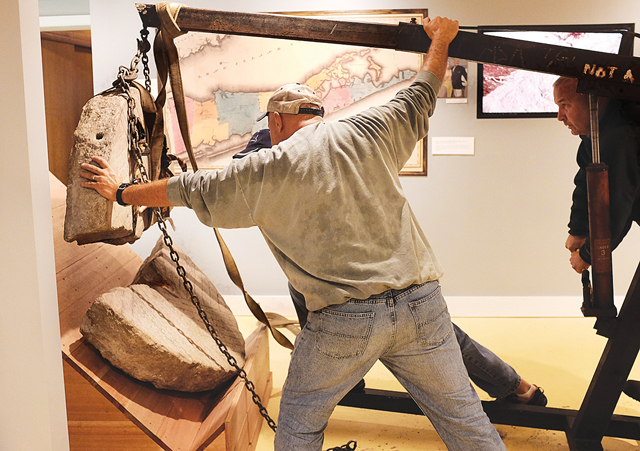Riverhead officer’s hunch leads to unusual discovery — a massive millstone


David Lessard was driving down West Main Street one day about three years ago when he passed a house that caught his attention. Mr. Lessard, who’s always had an interest in history, had been reading a book about Riverhead Town’s past and the home seemed strikingly similar to one he’d just read about.
“I went there and spoke with the family and asked, ‘Would you mind if I look out back?’” he said.
It might have seemed like an odd request, but his hunch was correct. Mr. Lessard, a lieutenant with the Riverhead Police Department, discovered a granite millstone, used to grind wheat and rye, dating back to the 1800s.
“[The millstone] was covered with a wooden deck over an old cement deck, so I couldn’t see between slabs to see if it was in there or not,” he said, adding that the family didn’t know the stone was there. “I went back and asked if I could take a couple boards off and it was there.”
Mr. Lessard eventually purchased the artifact and donated the 800- to 900-pound stone to Suffolk County Historical Society in Riverhead, where it was placed in the basement for storage.
About two weeks ago, he received a call from historical society executive director Victoria Berger asking for help moving it out of the basement and into the society’s new permanent exhibit, “Peconic River Power.” The exhibit features photographs of mills along the river dating back to the Colonial era, Ms. Berger said.
An engine hoist was needed to move the millstone, also known as a runner stone, out from among the antique cars in the basement and into its custom display case upstairs. Mr. Lessard and three friends — fellow town police officers Tom Lessard, Rich Anderson and George Bartunek — spent about six hours last weekend repositioning the stone.
“As far as the police angle, we just all happened to be cops,” he said. “I couldn’t think of anybody else who would help me move it.”
Due to its weight and size — 46 inches in diameter by 8 inches thick, the stone had to be moved in two pieces and was placed on wooden planks and rolled through the museum, Mr. Lessard said.
“We couldn’t be more grateful,” Ms. Berger said of the officers’ assistance. “We had the millstone for quite some time, but had no way to exhibit it because we didn’t have the manpower to get it up into a proper display … If it wasn’t for the efforts of these men and their volunteerism, we would not have been able to display it the way we are now.”
In its heyday, the millstone would “have been set on top of a bottom bed stone during the milling process and would have been used for grinding grain,” the historical society said in a release.
Although no longer used for grinding grain, the historic stone is the inspiration behind two common phrases.
“When they say the term ‘run of the mill,’ it means the first time the seed or wheat is in there, the first run through, is average,” he said. “To get it really ground, you have to do it again so it becomes very fine. It’s just kind of average on the first run.”
Another saying, “keep your nose to the grindstone,” alludes to the different uses of the top and bottom halves of the millstone mechanism. Ms. Berger said the stone at the historical society is the top portion.
“So when they say ‘keep your nose to the grindstone,’ it means you keep looking at and concentrating on the millstones because if the two came in contact there’s a chance it could spark and whatever was being [ground] could be combustible,” Mr. Lessard said. “You could blow up the whole mill.”
Courtesy photo: Tom Lessard moves the granite millstone found by his brother Dave into its new location. (Credit: Suffolk County Historical Society)








